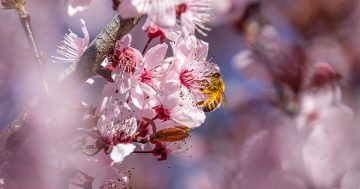
Gino Giucci on the mowing job – the busiest it’s been for some time, thanks to wet weather. Photo: Michelle Kroll.
During the 2020-21 financial year, the ACT Government increased its mowing of public lands by 43 per cent, Transport Canberra and City Services’ annual report has shown.
The government mowed just over 42,000 hectares of public land in the reporting period – an increase from the previous financial year (2019-20) in which just over 29,000 hectares of land was mown.
The report noted that the La Niña event of 2020 had thrown a spanner in the works.
“The annual grass mowing program normally runs from September to March. In 2020 a La Nina climate event resulted in a significant increase in rainfall and rapid grass growth,” the report read.
“In Spring 2020 it had become evident that mowing suburbs every four weeks would be extremely challenging.”
An additional $2.1 million of funding was plunged into the mowing program in November last year. This led to the creation of 24 new staff positions for 12 months and allowed for nine additional mowers to be hired.
Additional contracted resources were also allocated to the mowing. That funding was drawn from the government’s COVID-19 support package.
The mowing program will now continue to be reviewed throughout 2021-22, the report read.
Last month the Bureau of Meteorology declared a La Niña event, and November 2021 was the wettest November ever in the ACT – a total of 852.2 millimetres of rain were measured at Canberra Airport.
This recently led the Opposition to call on the ACT Government to update its mowing schedule in response to weather patterns and increased funding.
They’ve said more resources, surge funding and a better long-term strategy to get the mowing done is what’s needed.
Canberra Liberals MLA Jeremy Hanson seized on the mowing issue to say the government is no longer focused on the suburbs, nor on the things that matter the most to Canberrans.
The ACT Government instead noted the record rainfall, saying this was the reason behind mowing schedule delays of up to two weeks.
Minister for City Services Chris Steel said the government simply could not control the rain.
“Even with the best-laid plans, you can’t mow a lawn when it’s wet,” he said. “It damages the equipment and it’s a safety issue.”
Mr Steel did note that additional funding would be considered and could be drawn upon if required.
“We will continue to monitor the weather patterns that we are facing and, if it looks like additional surge funding may be needed, of course, we will consider that, just as we delivered during the last mowing season as well,” he told the Assembly.
He also described the delays of only two weeks as “pretty good when you consider the combined impact of the La Niña weather conditions and of the COVID-19 lockdown”.
Yet many Canberrans have decided it’s time to take the mowing matters into their own hands instead. ACT residents are expected to maintain their own verges, but some have taken to mowing community parks, nature strips and roundabouts.
An ACT Government spokesperson said this is appreciated but encouraged people to be safe and keep an eye out for potential hazards.





















